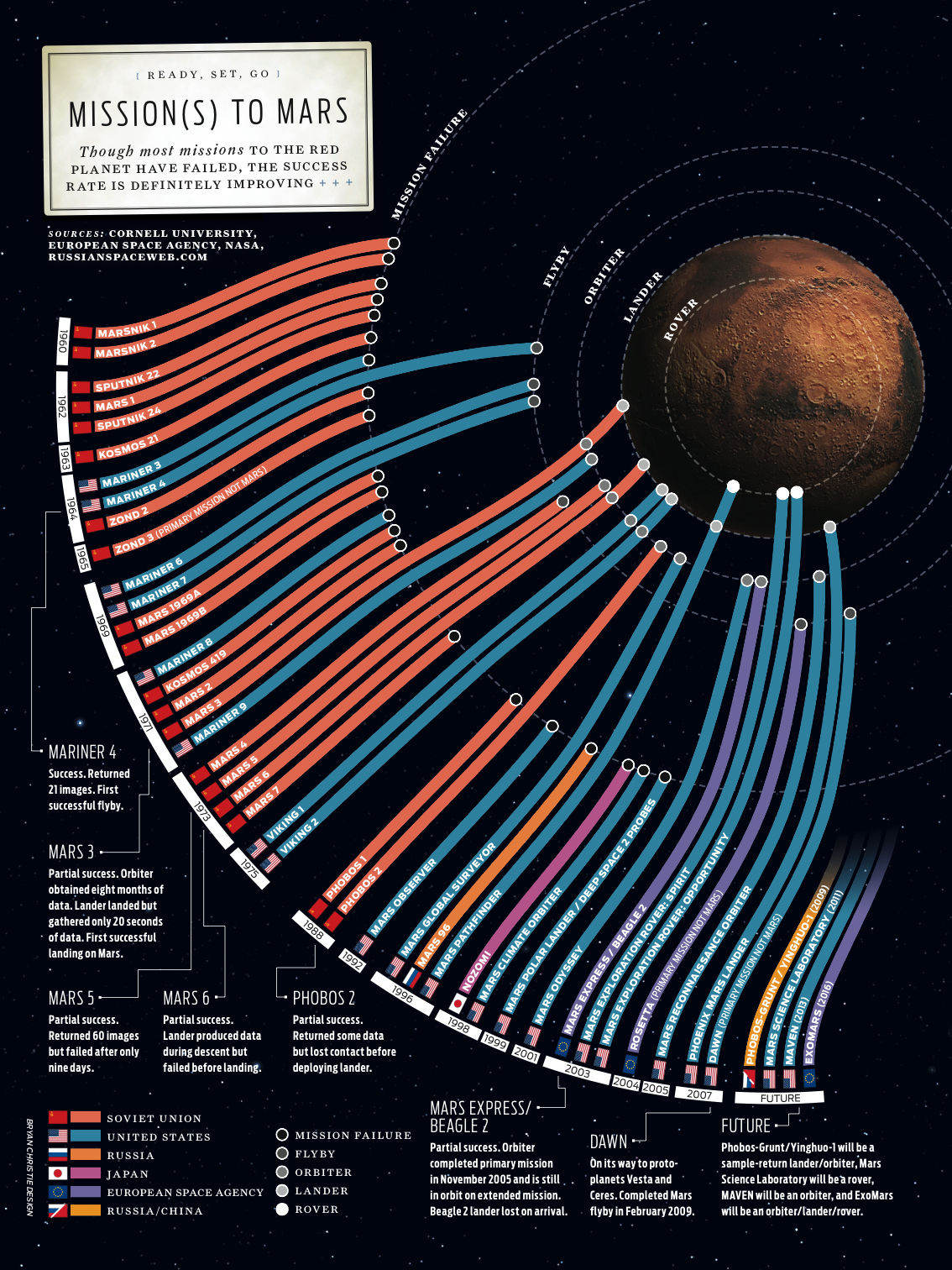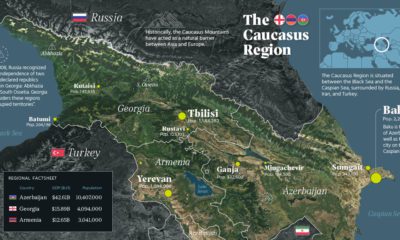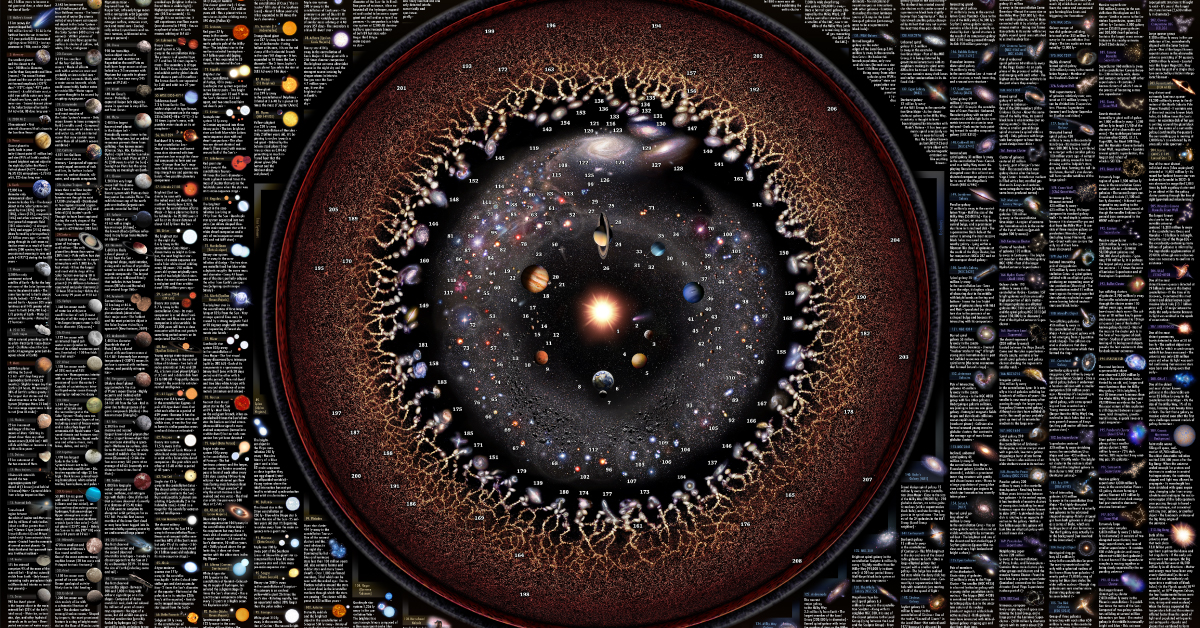For centuries, Mars has been mythically defined by its characteristic red appearance. In Babylonian astronomy, Mars was named after Nergal, the deity of fire, war, and destruction. In Chinese and Japanese texts, the planet was known as 火星, the fire star. Although this unique reddish hue has been a key defining characteristic of Mars in culture for centuries, today we now know that it’s the iron oxide soil of the Martian landscape that makes it the “Red Planet” – and that there is much more to Mars than its color upon closer observation. Above, today’s map, posted and created by Reddit user /hellofromthemoon, brings together the data from centuries of observation and the numerous missions to the Red Planet to map out its geology on a grand scale.
A Red Dot in the Sky
Egyptian astronomers first observed the planet Mars four thousand years ago and named it “Horus-the-red.” Babylonian astronomers marked its course through the night sky to track the passage of time. But it was not until 1610, when Galileo Galilei witnessed Mars with his own eyes through a telescope, that Mars was revealed as a whole other world. Over the centuries with improving technology, a succession of astronomers observed and crudely mapped out everything from polar ice caps to yellow clouds, and white and dark spots denoting varying elevations across the Martian surface. Some of the earliest maps of Mars date to 1831. But there is only so much you can accurately observe from the surface of the Earth. On July 14, 1965, NASA successfully received the first up-close images of Mars from the Mariner 4 spacecraft, passing within 9,844 kilometers (6,117 miles) of Mars’ surface. Mariner 4 captured the image of a large ancient crater and confirmed the existence of a thin atmosphere composed largely of carbon dioxide. Since then, four space agencies have successfully made it to Mars: NASA, the former Soviet Union space program, the European Space Agency and the Indian Space Research Organization. From orbital satellites to surface exploration with robots, each successful mission has brought back important data to develop an evolving picture of the planet. Here is a complete list of both the successful and failed missions to Mars.
Martian Geology
On Mars, we see volcanoes, canyons, and impact basins much like the ones on Earth. The yellows scattered across the map indicate meteor impacts of varying size while the swaths of red indicate volcanoes and their associated lava flows. The varying colors of brown indicate the cratered highlands and midlands that make up most of the southern hemisphere. The planet appears asymmetric. Most of the southern hemisphere is heavily cratered and resembles the moon’s highlands. In contrast, the northern hemisphere is sparsely cratered and has many large volcanoes. Mars is approximately one-half the diameter of the Earth, but both planets have the same amount of dry land. This is because the current surface of Mars has no liquid water. Mars and Earth are very different planets when it comes to temperature, size, and atmosphere, but geologic processes on the two planets are eerily similar. The sheer size of some landforms on Mars would shadow over similar features on Earth because of the lack of water erosion. This lack of erosion has preserved billion year-old geologic features. The tallest mountain on Mars and in the solar system is Olympus Mons, and it is two and a half times taller than Mt. Everest. A Martian canyon system, called Valles Marineris, is the length of the entire continental United States and three times deeper than the Grand Canyon.
Mars Colony: Location, Location, Location
The first step to building a colony is to figure out where the best chance of survival is. For Mars, some researchers have identified the planet’s poles, which contain millennia-old ice deposits. These are thought to contain large amounts of ice, which mars settlers could extract and turn into liquid water. The poles also host other natural resources, such as carbon dioxide, iron, aluminum, silicon and sulfur, which could be used to make glass, brick and plastic. Furthermore, the planet’s atmosphere contains enough hydrogen and methanol for fuel.
Closing the Distance
The map above represents the culmination of centuries of work which we are lucky enough to view here on a computer, conveniently online for us to appreciate and wonder what life’s like on the surface of Mars. Who knows what more exploration will reveal. on And while we haven’t figured out all the answers quite yet, we’ve made some remarkable discoveries when it comes to learning about outer space. What are some of the most notable observations that scientists have discovered so far? This map of outer space by Pablo Carlos Budassi highlights more than 200 celestial objects in our universe and provides details and facts about each one.
The Types of Celestial Objects Mapped
To create this graphic, Budassi used a combination of logarithmic astronomical maps from Princeton University, as well as images from NASA. The visualization highlights 216 different celestial objects that are color-coded and organized into five overarching categories:
Moons and Asteroids Planets Galaxies Star System Great Scales/Superclusters
At the center of the map is the Sun, which is the largest object in our Solar System. According to NASA, the Sun’s volume is equivalent to 1.3 million Earths. The Sun is the powerhouse of life here on Earth—its energy provides our planet with a mild, warm climate that keeps us alive, keeping the Earth from becoming a frozen rock. While the Sun is the only star in the Solar System, there is a neighboring star system called Alpha Centauri that’s approximately 4.37 light-years away. It’s made up of three stars—Proxima Centauri, Alpha Centauri A, and Alpha Centauri B. Proxima Centauri, as the Latin name indicates, is the closest of the three to Earth and has an Earth-sized planet in its habitable zone.
The Life of a Star
In a star’s early stages, it’s powered by hydrogen. However, when its hydrogen stores are depleted, some stars are able to fuse helium or even heavier elements. Stars similar to the size of the Sun will grow, cool down, and eventually transform into a red giant. The Sun has about 5,000 million more years before it reaches its red giant stage, but when that happens, it will likely expand to the point where it swallows up the Earth. While stars emit energy for years, it’s important to note that they don’t shine for eternity. Their exact life span depends on their size, with bigger stars burning out faster than their smaller counterparts. But as light from distant objects millions of light-years away takes a long time to reach us here on Earth, the largest of stars shine for hundreds of millions of years after they die.
Just How Big is Our Universe?
Some experts believe that the universe is infinite, while others argue that we can’t yet know for certain because current measurements aren’t accurate enough. However, scientists believe that our observable universe extends about 46 billion light-years in every direction, giving it a diameter of roughly 93 billion light-years. But just how much of the universe extends beyond what we can see? We may never find out.














